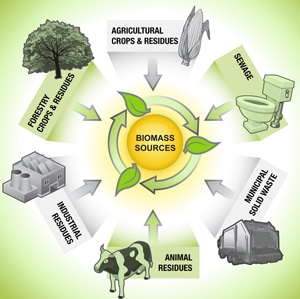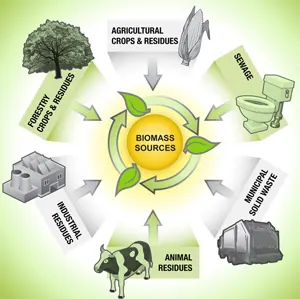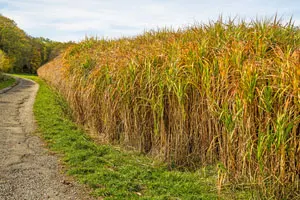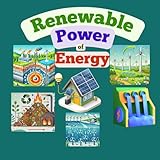
Biomass Resources
Biomass Resources and Biorenewable Resources
![]() The term Biomass Resources, sometimes referred to as biorenewable resources, are all forms of organic materials, including plant matter both living and in waste form, as well as animal matter and their waste products. As such biomass resources are generally classified as being either waste materials or dedicated energy crops.
The term Biomass Resources, sometimes referred to as biorenewable resources, are all forms of organic materials, including plant matter both living and in waste form, as well as animal matter and their waste products. As such biomass resources are generally classified as being either waste materials or dedicated energy crops.
A waste material can be any municipal solid waste and industrial waste material that has been discarded because it no longer has any apparent value to the user or which represents a nuisance or even a potential pollutant to the local environment. If the organic waste products from one process was used as primary source of feedstock in another process.
For example, materials such as waste cardboard, wood and paper recycled into newspapers, books and magazines, etc. If these waste materials were economically converted into electricity, heat, liquid biofuels, or chemicals, then they could be considered as a biomass resource rather than an unwanted waste stream.

Waste materials that would qualify as a biorenewable resource include agricultural residues, yard and garden waste, municipal solid waste, food processing waste, animal manure, etc. Existing landfill areas are now filled beyond capacity.
The search for new landfill sites for the dumping of solid waste is becoming increasingly difficult due to public protest. Finding new landfill sites away from urbanized areas means that the longer distance travelled from the city center increases the wastes transportation cost tremendously.
But the energy generated from waste cannot be ignored as a valuable bioenergy source. If effectively harnessed, the energy produced from wastes can be used to lessen the demand for energy generation using non-renewable fossil fuel sources.
Furthermore, the generation of energy from solid waste materials brings extra significance by reducing the volume of the the unwanted waste, saving on landfill space and providing a biomass resource which would otherwise be of no value.
Solid Biomass Resources
So what types of solid waste materials qualify as a biorenewable resource.
- Agricultural Residues are the non-edible stalk type materials that remain after the harvest of the edible portions of the crops, such as corn, wheat, grain and sugar cane. Agricultural residues also includes plant leaves, husks, some roots and stems. The residues of dedicated bioenergy non-food crops grown for their starches, sugars, or oils for the conversion into bioethanol and biolubricants. The advantage of agricultural residues is that they do not require the use of additional land space because they are grown together with the food crops.
- Food Processing Waste is the effluent wastes from a wide variety of industrial processes ranging from breakfast and cereal bar manufacturers to fresh and frozen vegetable manufacturers to alcohol breweries. These residues and wastes can be in the form of either dry solids or watery liquids. Fermentation of liquid wastes and oils from food processing can produce Ethanol.
- Municipal Solid Waste this is the items that are thrown away in the garbage and trash and is collected by the dustbin men or sent to the recycling centre. Municipal solid waste such as particularly paper, cardboard, and discarded food products, is an attractive source of endless biomass feedstock. However, not all municipal waste is suitable as a biomass resource, especially metallic and plastic waste.
- Animal Waste from farms, ranches, slaughterhouses, fisheries and dairies or any concentration of animals into giant livestock farming facilities produces large amounts of manure and sewage sludge. Liquid sewage, animal wastes, and also human waste from urban areas, provides a constant source of chemical energy and gases which can be converted into electrical power at these wastewater treatment plants. The treatment of animal waste produces combustible methane and biogas which can then be used for heating and transportation.
The management and disposal of solid waste has become one of the major problems we are facing today. An increase in the volume of unwanted waste is one aspect of the current environmental crisis. Other than the the difficulty in characterising the waste material, due in part to its variable and complex composition, many waste materials share a few common attributes with each other, with the principal one being their low cost.
Because of this, solid waste materials have little or no apparent economic value and can therefore be acquired for little more than their cost of transportation. In some cases, waste is regarded as a negative cost due to the every increasing costs of skip hire for solid waste disposal or the restrictions on the disposal of certain types of wastes at landfill sites, many companies or households are only to happy to pay someone to dispose of their waste as a biorenewable resource for processing.
Clearly, waste materials which can be reprocessed into biomass feedstock for use in an energy conversion process are therefore no longer classed as an unwanted waste material with the demand for these new-found renewable biomass resources on the increase. As waste now presents itself as an attractive biorenewable resource, many now demand payment for their waste. Then those companies or households that generate the waste now view themselves as waste suppliers turning what was once a negative cost into a positive profit.
But as well as using waste materials as a biomass resource, dedicated energy crops can be grown specifically as an energy source. These dedicated energy crops are not only greener and cleaner with respect to solid waste materials, but their use represents a closed and balanced carbon cycle with regards to atmospheric carbon dioxide.
Dedicated Biomass Energy Crops
Until now, biomass energy crops have been largely ignored in favour of growing food crops to feed people and animals, but as fuel prices increase and fossil fuel supplies run low, interest is now increasing as the economics of extracting fossil fuel energy becomes more expensive and complex. But as well as using the waste of agricultural crops, it is also possible to grow crops specifically for the production of energy in the form of energy crops.
The Earth holds huge stocks of biorenewable and biomass resources covering wide regions of the planet, from fields, to forests, to the oceans. Already there is large scale production of energy crops around the world, including those that produce biofuels and biolubricants.
Whether or not it is sustainable or viable to use such large areas of farmland and forests to produce dedicated energy crops has been the subject of much debate over the years as each crop must compete for arable farmland with existing uses and of course with each other.
Energy crops are defined as plants and crops grown specifically as an energy resource. The current production of biomass resources includes primarily agricultural byproducts, (Herbaceous crops) and forestry byproducts, (woody biomass crops).
But when agricultural crops are grown solely for their energy production, either as a biomass resource or as a biofuel, the plant species that offers the most efficiency and the least pollution potentials are usually selected. Energy crops grown specifically as biomass resources include energy cane, sorghum, sugar cane, eucalyptus trees, switch grass, miscanthus, giant reeds, and leauceana lucacephala, etc. which are then planted and harvested periodically.
Dedicated energy crops can provide up to five or six times more potential energy than the amount of energy required to grow and produce them. Energy crops can also be environmentally friendly with many of the plants grown as for biomass resources being advantageous to the environment. Switch grass, for example, helps reduce soil erosion due to their deep roots and provides a natural habitat for local wildlife and of course, these types of energy crops are 100% biodegradable.
Dedicated energy crops contain significant quantities of one or more of four important energy-rich components: oils, sugars, starches, and fibre. However, moisture content of the crop is a major factor when considering the use of a biomass feedstock, especially as energy. Biomass resources and herbaceous grasses which have lower moisture content at the time of harvesting have a major advantage that grass energy crops have over greener woodier energy crops.
- Herbaceous Energy Crops, these are plants that have little or no woody tissue such as grasses and legumes grown on grasslands. Generally speaking, food crops, such as maize, wheat, rice and sugarcane represent good sources of herbaceous biomass. Some byproducts or residues of crop cultivation, such as stalks and stems, can also be considered as herbaceous biomass.

Switchgrass and miscanthus form the primary production of herbaceous crops as these tropical grasses tend to grow faster than woody trees and can produce higher amounts of biomass feedstock in a much shorter period. Generally the growth of these herbaceous plants usually lives for only a single growing season. - Woody Energy Crops include hardwoods and softwoods form the basis of most biomass resources. The primary source of woody energy crops comes from fast growing trees and plantations, but woody biomass can also be a residue from forestry activities (timber waste), from wood processing (industrial wood, sawdust, wood shavings), and end-of-life wood products (bulky waste, demolition, pallets). Woody biomass is cut into uniform, small pieces called wood chips. Highly efficient and non-polluting burners and stoves can be designed to burn these chips for cooking and heating.
- Lipids are water insoluble oils and fats obtained from recently living biomass. For example, soybean oil, palm oil, rapeseed oil, waxes and animal fats and greases, etc. Renewable lipid feedstock also includes algae, bacteria’s and other such micro-organisms. Algae are among the fastest growing types organisms in the world, with about half of their weight being oil. The liquid biofuel, usually in the form of alcohol or ethanol, can be used to produce biodiesel to power cars, trucks, and even aeroplanes.
The carbon-neutrality of biomass resources made from energy crops relies on the new biomass balancing or at least outstripping the biomass grown for food. Biomass is generally considered to be an excellent carbon sink with biomass feedstocks planted specifically as an energy crop, are likely to play a longer term role in providing sustainable sources for heating and power generation.
But land availability for growing food crops is becoming more scarce, so any competition for using fertile arable land to plant biomass energy crops should therefore be avoided. Besides, dedicated energy crops such as grasses, bamboo, reeds and canes are more appropriate for land unsuitable for agriculture.
Biomass Resources Conclusion
Biomass feedstocks can be used in a variety of different ways to meet our ever increasing energy needs. These biomass power resources can be used in the generation of electricity, (direct or co-firing) for heating our homes, or for powering of vehicles once converted to biofuels. The technologies used for the conversion of biomass resources into a usable energy includes, direct combustion processes, biochemical processes, thermochemical processes and agrochemical processes.
For dedicated energy crops to be a major source of biomass, their current costs must be reduced. The development of various crop species (agriculture and trees) that are highly productive in energy storage, resistant to climate and site conditions, resistant to pests, and efficient in using nutrients are now being developed around the world.
Mechanized harvesting equipment once used to harvest food crops can be adapted to make it more economical to harvest energy biomass resources that are normally too costly to collect using traditional techniques.
Biofuels produced from biomass feedstocks are now well established in the market place, with many vehicles designed to run on these biorenewable liquid fuels such as ethanol, methanol as well as synthetic hydrocarbon fuels developed from biomass oils extracted from rape seed, sunflowers, oil palms or from aquatic plants.
We have seen here that Biomass Resources available for energy production encompasses a wide range of plants and materials ranging from agricultural and forest crops specifically grown for energy purposes, agricultural and forest wastes and residues, wastes from food processing and fisheries, municipal waste including sewage sludge, as well as aquatic plants and algae.
One biomass material that is quite abundant is peat moss allowing you to make peat pellets from sphagnum moss materials. However, sphagnum peat moss is the principle material of peatland ecosystems which contribute to the sequestration and long-term storage of atmospheric carbon.
As biomass waste is available in a very dispersed manner, unlike fossil fuel deposits, the cost of collecting and transporting large quantities of biomass materials for energy production can be significant since these materials by their very nature are widely dispersed, or of low energy density. Therefore, the most attractive sources of biomass energy today generally involves biomass resources that have been collected for other reasons, or grown and cultivated as a dedicated energy crop.
To gain a better understanding of what you can use as “Biomass Resources”, or to obtain more information about the various biorenewable resources available for use in your home, or just to explore the advantages and disadvantages of what biomass energy and biorenewable resources can do for you, then Click Here to get your copy from Amazon of one of the top “Biomass Books” today to learn more about the different types of biomass resources available in your home to help you save money and the environment.











Who is the author of this article???
Alternative Energy Tutorials
The only natural, renewable carbon resource known that is large enough to be used as a substitute for fossil fuels is biomass . Unlike fossil fuel deposits, biomass is renewable in the sense that only a short period of time is needed to replace what is used as an energy resource .